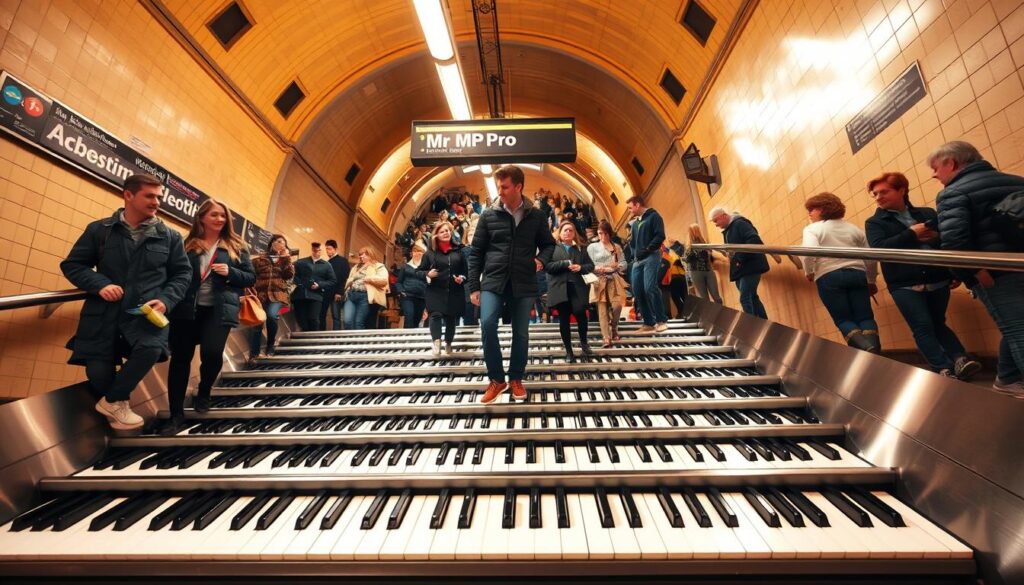
Imagine a world where taking the stairs becomes more appealing than riding the elevator. Welcome to the “Fun Theory” campaign, where everyday urban environments were transformed into playful experiences. This innovative initiative, which included experiments like the now-famous piano staircase, aimed to change behavior by making the right choice an enjoyable one.
The campaign’s viral success was undeniable. Videos showcasing these playful interventions spread rapidly across the globe, capturing the attention of millions. One notable example was the piano staircase experiment, which led to a 66% increase in stair usage. This creative approach not only promoted healthy habits but also highlighted the power of fun in driving positive change.
By focusing on enjoyment rather than guilt, the campaign effectively encouraged eco-friendly behavior. The key takeaway? Fun can be a powerful tool for driving change. For more insights on how technology is revolutionizing our world, check out this article.
Introduction to the Fun Theory Concept
Have you ever wondered how everyday activities could become more engaging? The Fun Theory offers a fascinating answer. This concept suggests that making tasks enjoyable can significantly influence behavior, encouraging people to make better choices.
What is the Fun Theory?
The Fun Theory is a simple idea: adding enjoyment to daily tasks can change how people behave. For example, turning a staircase into a piano keyboard made people more likely to choose the stairs over the escalator. This creative approach shows how fun can drive positive actions.
The Rise of Innovative Marketing
In 2009, a unique marketing strategy was launched, blending public experiments with innovative advertising. One notable experiment was the piano stairs at a metro station, which became a viral sensation. The idea was to show how fun could lead to eco-friendly choices, like taking the stairs instead of the escalator.
This approach not only engaged the public but also highlighted the power of enjoyment in changing habits. By focusing on fun, the campaign inspired people to make healthier and more environmentally responsible decisions. To learn more about innovative strategies that drive change, visit this resource for insights into effective marketing techniques.
Exploring the Volkswagen Fun Theory Campaign
In 2009, a unique partnership between Volkswagen and DDB Stockholm gave birth to the Fun Theory campaign. This innovative initiative aimed to encourage eco-friendly behavior by making everyday activities more enjoyable. The campaign’s core idea was simple: make the right choice the fun choice.
Campaign Origins and Objectives
The campaign was designed to promote Volkswagen’s BlueMotion technologies through playful experiments. One of the most iconic examples was the piano stair experiment. By transforming a staircase into a piano keyboard, the campaign encouraged people to choose the stairs over the escalator. This creative approach led to a 66% increase in stair usage, showing how fun could drive positive change.
Linking Fun with Eco-Friendly Innovations
The piano stair experiment set the tone for the campaign, demonstrating how engaging public experiments could replace traditional marketing. This strategy not only promoted eco-friendly habits but also highlighted the effectiveness of playful experiences in changing behavior. For instance, the speed camera lottery rewarded drivers for adhering to speed limits, further showcasing the campaign’s innovative approach. To learn more about how creative strategies can enhance engagement, visit this resource for insights into effective marketing techniques.

Interactive Experiments: Piano Stairs, Talking Bins, & Bottle Banks
Interactive experiments like the piano stairs and talking bins brought the Fun Theory to life in creative ways. These engaging installations were designed to make everyday tasks more enjoyable, encouraging people to make better choices.
Piano Stairs: Playing Your Way Up
The piano stairs were one of the most iconic experiments. Each step played a musical note when stepped on, turning the staircase into a giant piano. This creative design made taking the stairs more appealing than using the escalator, leading to a 66% increase in stair usage.
Talking Bins and Arcade Bottle Banks
The talking bins emitted comical crashing sounds when used, making waste disposal more entertaining. Similarly, the arcade-style bottle banks turned recycling into a game, boosting participation. These experiments showed how fun could transform mundane tasks into enjoyable activities.
| Experiment | Design | Impact |
|---|---|---|
| Piano Stairs | Staircase that plays musical notes | 66% increase in stair usage |
| Talking Bins | Bins that make crashing sounds | Increased proper recycling |
| Arcade Bottle Banks | Game-like recycling system | Boosted recycling participation |
These experiments demonstrated how interactive elements and sound effects could engage the public and change habits. By focusing on fun, the campaign inspired people to make healthier and more environmentally responsible decisions. For more insights on how technology is revolutionizing our world, check out this article.

Changing Behavior Through Playful Experiences
Have you ever thought about how simple changes in your surroundings could inspire you to make more sustainable choices? The “Fun Theory” initiative offers a creative solution by transforming everyday environments into engaging experiences that encourage eco-friendly behavior.
Driving Sustainable Actions
At the heart of this approach is the idea that making tasks enjoyable can lead to positive change. For instance, turning a subway staircase into a piano keyboard made taking the stairs more appealing than using the escalator. This playful intervention led to a 66% increase in stair usage, showing how fun can drive sustainable actions.
Real-World Impact at Metro Stations and Beyond
One notable example is the piano stairs installed at a metro station, which became a viral sensation. This experiment not only promoted physical activity but also highlighted the power of enjoyable experiences in changing habits. Similarly, interactive recycling bins that made sounds when used encouraged people to participate in eco-friendly practices.
| Experiment | Design | Impact |
|---|---|---|
| Piano Stairs | Staircase that plays musical notes | 66% increase in stair usage |
| Talking Bins | Bins that make crashing sounds | Increased proper recycling |
| Arcade Bottle Banks | Game-like recycling system | Boosted recycling participation |
These playful interventions demonstrate how interactive experiences can engage the public and lead to measurable behavior change. By focusing on fun, the initiative inspired people to make healthier and more environmentally responsible decisions. For more insights on how creative strategies can drive change, visit this resource for innovative marketing techniques.

Conclusion
The Fun Theory initiative has proven that turning everyday activities into playful experiences can lead to significant behavioral changes. By transforming ordinary tasks into engaging experiences, the campaign inspired people to make eco-friendly choices without feeling forced. The iconic piano stairs, which became a viral sensation, demonstrated how fun could drive sustainable actions, with a 66% increase in stair usage at a subway station.
The campaign’s success went beyond just numbers. It showed how creative, interactive approaches could solve urban and environmental challenges. The idea that making the “right thing” fun could lead to lasting change influenced future marketing strategies and eco-friendly innovations. This approach encouraged people to think differently about their daily choices, from taking the stairs to recycling, by making these tasks enjoyable.
As you reflect on the Fun Theory legacy, consider how elements of fun can be applied to everyday decision-making. By leveraging playfulness, we can inspire engagement and change, both personally and societally. The campaign reminds us that fun and functionality can co-exist, creating a better world where the right choices are also the enjoyable ones.

 Volkswagen’s “Fun Theory” Campaign: Turning Everyday Moments into Playful Experiences
Volkswagen’s “Fun Theory” Campaign: Turning Everyday Moments into Playful Experiences
0 Comment